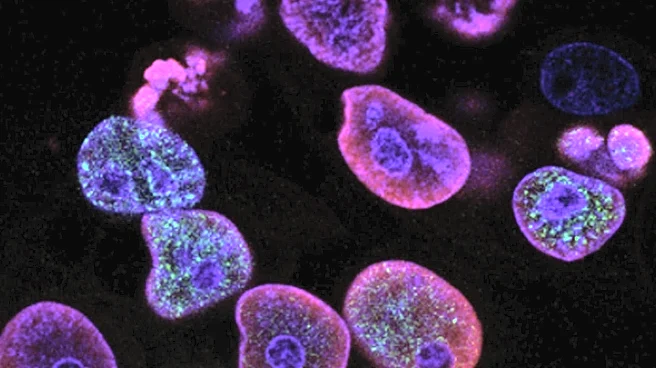What's Happening?
Researchers at The University of Tokyo have discovered a significant link between gray hair and cancer, focusing on the behavior of melanocyte stem cells (McSCs). These cells are responsible for producing
melanocytes, which give color to hair and skin. The study, published in Nature Cell Biology, reveals that when McSCs experience DNA damage, they undergo a process called senescence-coupled differentiation, leading to hair graying. This process is controlled by the p53-p21 signaling pathway. However, when exposed to certain carcinogens, these cells avoid this protective differentiation and continue to renew themselves, potentially leading to cancer. The study highlights that the same stem cell population can either exhaust or expand based on the type of stress and environmental signals, reframing hair graying and melanoma as divergent outcomes of stem cell stress responses.
Why It's Important?
This research provides crucial insights into the biological processes linking aging and cancer. Understanding how stem cells respond to DNA damage and environmental stressors can inform strategies to prevent cancer. The findings suggest that the natural process of senescence-coupled differentiation serves as a defense mechanism to remove damaged cells, preventing them from becoming cancerous. This has implications for developing therapies that could enhance this natural protective mechanism, potentially reducing cancer risk. The study also emphasizes the importance of the microenvironment in determining cell fate, which could lead to new approaches in cancer prevention and treatment.
What's Next?
Future research may focus on further exploring the molecular pathways involved in stem cell differentiation and cancer prevention. There is potential for developing treatments that mimic or enhance the natural senescence-coupled differentiation process to prevent cancer. Additionally, understanding the role of environmental signals in stem cell behavior could lead to new preventive strategies against carcinogen-induced cancers. Researchers may also investigate the broader implications of these findings for other types of stem cells and tissues, potentially leading to breakthroughs in regenerative medicine and aging.
Beyond the Headlines
The study highlights the complex interplay between aging, cancer, and cellular self-destruction. It underscores the importance of naturally removing compromised stem cells to prevent malignancy, a process known as senolysis. This research could shift the focus of cancer prevention strategies towards enhancing the body's natural defenses against damaged cells. It also raises ethical considerations regarding the manipulation of stem cell pathways for therapeutic purposes, emphasizing the need for careful evaluation of potential risks and benefits.











